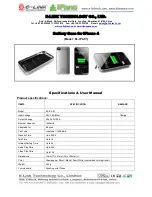
- 22 -
LGE Internal Use Only
Copyright © 2009 LG Electronics. Inc. All right reserved.
Only for training and service purposes
3. Technical Brief
BL20
G
G
_
3.3.1 UMTS RECEIVER
The antenna collects the base station forward-link signal and radiates the phone’s reverse-link signal. In the
example of a multiband, multimode phone (Figure 1.2.2.1), a switch routes the antenna signals to one of the
three UMTS Rx/Tx paths, each begining with its own band-specific duplexer that separates that band’s receive
and transmit paths
[Figure 1.3.2] WCDMA Receiver schematic
Each UMTS duplexer provides a differential output signal that is comlatible with its QSC LNA input. The
duplexer-to-LNA interface requires a differential matching network (MN) thatoptimizes the power transfer
into the LNA. Although there are three UMTS LNAs, only one is active at a time. The active gain-stepped LNA
output drives a shared quadrature
Downconverter directly —an off-chip inter-stage filter is not required. The elimination of this filter is achieved
by a combination of factors:
-New on-chip QSC processing
-Higher performance achieved by the differential duplexer-to-LNA interface
-Greater duplexer suppression of Tx leakage
The downconverter’sRF circuitry includes another gain-stepped amplifier that supplements the LNA gain
steps to further extend the receiver dynamic range. The downconvertertranslates the active LNA’sRF signal
directly to baseband, producing two analog outputs: in-phase (I) and quadrature (Q). The UMTS baseband
signals are routed to lowpassfilters whose passbandand stopbandcharacteristics are optimized for the active
WCDMA waveform. Both filter outputs are buffered to drive their analog-to-digital converters for digitization.
The digital baseband outputs are routed to QSC baseband circuits for further processing.
















































